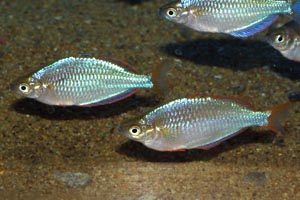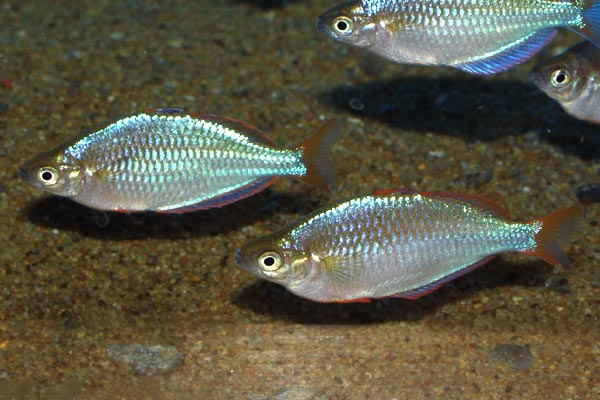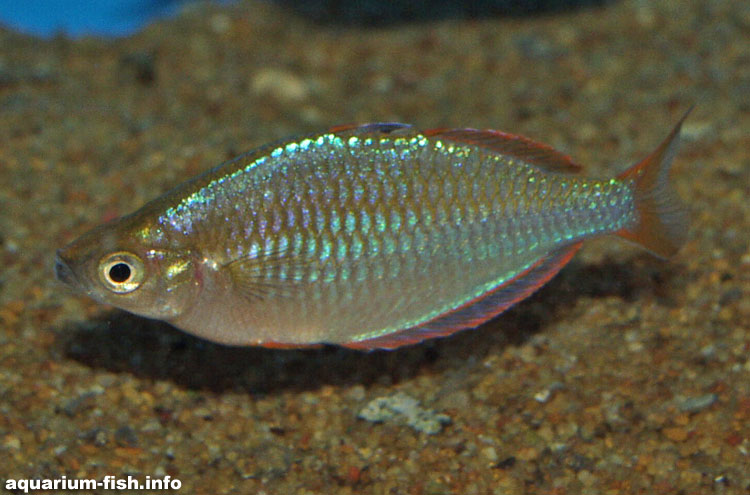

Species Profile | Images | Breeding Report | Similar Species

(Other members of the genus Melanotaenia)
ADULT SIZE: 8 cm
WATER CONDITIONS: Very hard and alkaline
TEMPERATURE RANGE: 23-27 C
FOOD: Feed Melanotaenia praecox live and dried foods. Not a fussy eater.
DISTRIBUTION: This species comes from Indonesia
SEXUAL DIFFERENCES: Male fish tend to be more brightly coloured in the fins, and have somewhat deeper bodies.
AQUARIUM CARE: Dwarf neon rainbowfish hail from the Mamberamo river system in northern Irian Jaya, Indonesia. This huge river has numerous micro-habitats; M. praecox is thought to prefer shallow areas with submerged plants and driftwood. In the aquarium, this is easily replicated, and floating plants also seem to make this fish more comfortable. Some open water is also important for free-swimming, and as a shoaling fish, it should be kept in a group of at least six individuals.
BREEDING: M. praecox is a typical plant spawning rainbow; eggs are attached to plants, then left to develop with no attention from the parents. Spawning mops can be used instead of plants to allow eggs to be collected and raised in a separate spawning tank. Egg development takes a little over a week, and fry relish newly hatched artemia nauplii.
Have you bred Melanotaenia praecox? Why not fill in a breeding questionaire?, or examine existing Melanotaenia praecox breeding reports
Other members of the genus Melanotaenia
Other rainbowfish species
Other species from Indonesia

Male dwarf neon rainbows have red fin edges. Females can also have red fin edges, though usually less intense, or orange/yellow

Melanotaenia praecox typically only reach an adult size of 8cm; smaller than many other rainbowfish
BREEDING: M. praecox is a typical plant spawning rainbow; eggs are attached to plants, then left to develop with no attention from the parents. Spawning mops can be used instead of plants to allow eggs to be collected and raised in a separate spawning tank. Egg development takes a little over a week, and fry relish newly hatched artemia nauplii.
Have you bred Melanotaenia praecox? Why not fill in a breeding questionaire?
This page summarises breeding reports provided by visitors to this site, along with some statistical analysis. Please feel free to contribute - whatever your experience!
| |||||||||
|
| ||||||||
|
| ||||||||
| |||||||||
|
| ||||||||
Remember, each record represents only one persons experience; if you had different results, or used different methods, please share your experiences
| Water conditions: Neutral | Water temperature: 24-27oC |
| Disposition: Active, but not aggresive | Community tank?: Yes, a good community fish |
| Spawning Method: Other (see below) | Breeding problems: none |
| Sex ratio: Roughly equal | Breeding difficulty: Very easy |
| Sucess: Fairly sucessful | Years Experience: 5 |
| Other Comments: I keep them in a small outdoor pond, heavily planted with no filtraton. I do not do anything special to breed them. I know they've bred only when I see 1 cm fry swimming about. | |
| Date this record created: 28th May 2009 | Breeding date: 2009 |
| Breeder: | Location: Manila, Philippines |